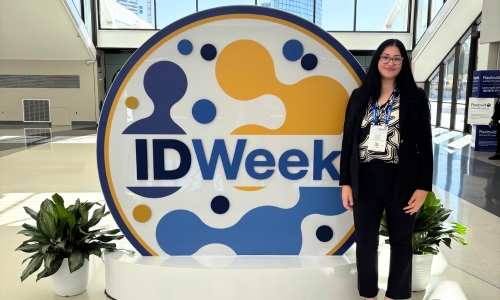
Long before she joined Michigan State University’s College of Osteopathic Medicine, Olivia Slewa knew she wanted a career in medicine.
“I initially got an interest in medicine probably early in middle school,” Slewa said. “I was really interested in science and then I really started liking research in high school.”
As her curiosity in medicine and medical research grew, Slewa began searching for medical schools that offered opportunities to conduct meaningful research while learning. MSU’s College of Osteopathic Medicine became a natural fit.
“Something that drew me to [the college] was research opportunities and the global health connections,” she said.
Slewa joined the College of Osteopathic Medicine in 2024, hoping to gain knowledge and research experience in women’s health, specifically reproductive and sexual health. During the summer of 2025, her research focus took her to a prominent location for holistic health research: Peru.
She was among a group of MSU medical students who traveled to Peru through the MSU Global Health Studies Education Abroad program. The group visited the capital city of Lima and learned from local practitioners about Peru’s healthcare practices. In the rural village of Iquitos, Slewa combined her interests in global and women’s health by helping lead a study on gauging HPV awareness and knowledge of cervical screening and HPV vaccination as preventative methods.
“In that community [Iquitos], there’s large health disparities,” Slewa said. “There aren’t a lot of hospitals and it’s difficult for people to access care. So while we’re there, I specifically focused on overseeing the gynecological procedures.”
Slewa and fellow researchers conducted a survey to gather data on HPV awareness, prevalence, vaccination rates and interest in vaccination in Iquitos, along with understanding the community’s beliefs and perceptions towards HPV. They then compared responses to those from participants in La Libertad, a province in Peru that includes the city of Trujillo. Their data analysis focused on comparing the prevalence of HPV genotypes in the two regions and using the insights on local perceptions to determine potential tools for prevention.
“A big difference [in the findings] was the prevalence of HPV in Iquitos,” Slewa noted. “The rate of HPV, regardless of the genotype, was higher. In 2024 [the HPV rate] was around 36 percent while La Libertad it was around 26 percent.”
In addition to the variance in HPV rates, Slewa’s findings showed that certain risk factors contributed to increased prevalence.
“A positive predictor was if the age of sexual debut was less than 14,” she said. “Some other risk factors were inconsistency of condom usage. Although this seems like ‘that makes sense,’ a lot of these communities are rural and don’t have access to these. Also, social stigma and sexual education around preventing STIs were factors.”
Slewa and a team of fellow MSU students submitted the HPV study to IDWeek, an annual conference hosted by the Infectious Diseases Society of America, the Society for Healthcare Epidemiology of America, the HIV Medicine Association, the Pediatric Infectious Diseases Society and the Society of Infectious Diseases Pharmacists. Their abstract was accepted for a poster presentation, giving Slewa the opportunity to showcase the study to medical leaders from across the United States.
“I was really excited to talk to people about [the study], and I had really interesting conversations with people and they were very interested in the topic and relevance to the community as well,” she said. “That made me really happy because I wanted to do my best to make sure I was representing the community well.”
